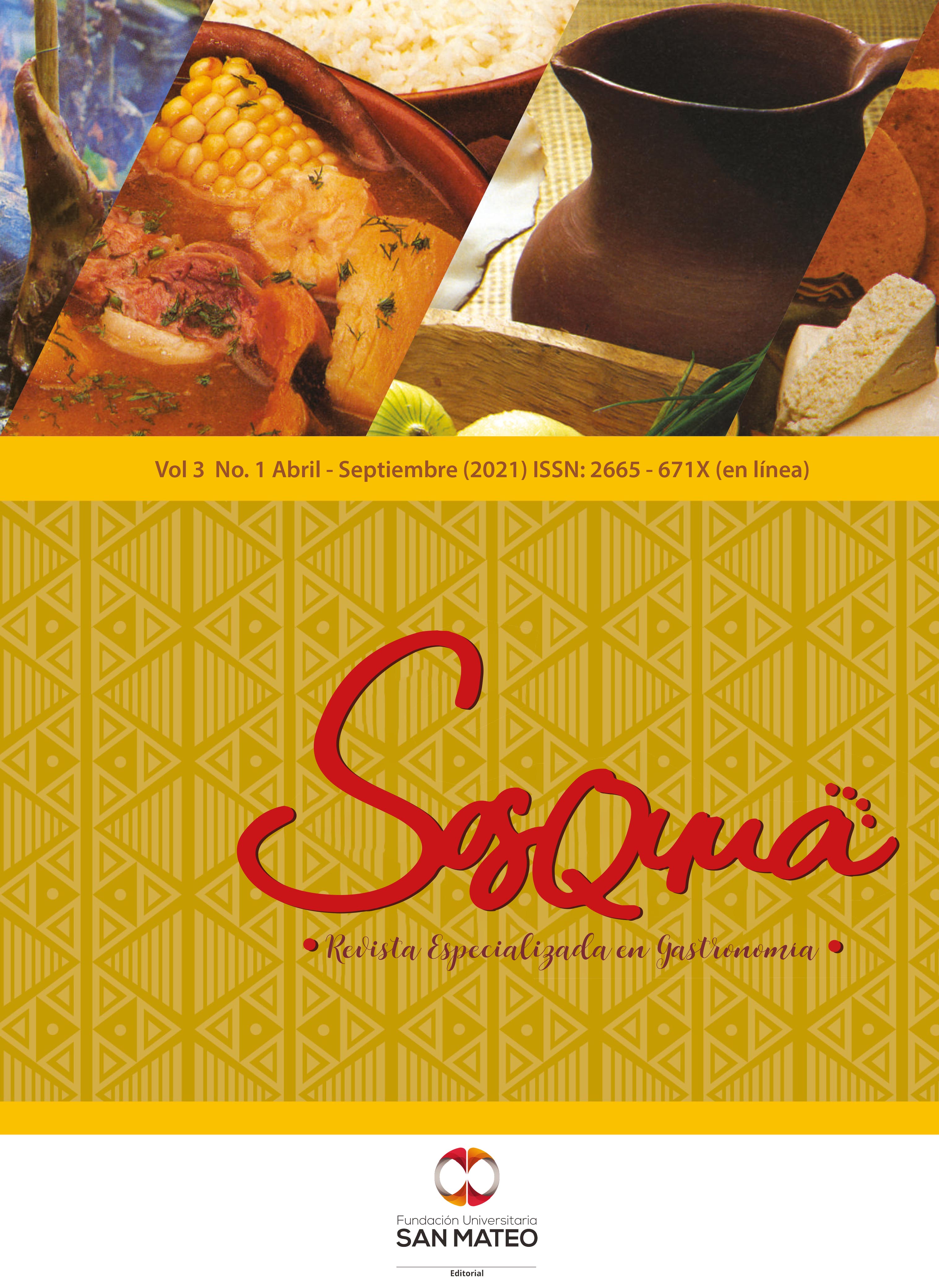Colombian gastronomy ancestral practices and knowledges in Cundinamarca department, east province, 2020
Main Article Content
Abstract
Downloads
Article Details

This work is licensed under a Creative Commons Attribution-NonCommercial-NoDerivatives 4.0 International License.
Sosquua. Revista Especializada en Gastronomía está comprometida con la preservación del medio ambiente, razón por la que se edita digitalmente a través de la plataforma de acceso abierto: Open Journal System –OJS; la cual permite consolidar una gestión editorial eficiente para cada fase y actor interviniente en el proceso de publicación.
- No genera a los autores pago alguno por gastos de procesamiento de artículos (APC), ni cargos por envío de artículos.
- Así mismo, la suscripción en línea es libre y gratuita.
Los autores de Sosquua. Revista Especialiazada en Gastronomía proporcionan la circulación de sus contenidos a la Fundación Universitaria San Mateo mediante licencia Creative Commons Atribución-NoComercial-SinDerivar 4.0 que permite a terceros compartir la obra siempre que se indique su autor y su primera publicación esta revista.

- Los usuarios pueden consultar el contenido de esta obra a través del sistema de repositorios internos y/o externos en donde la Fundación Universitaria San Mateo tiene o tenga presencia, en la página Web, así como en las redes de información del país y el exterior, con las cuales tenga convenio la institución.
- Se permite la consulta, reproducción parcial, total o cambio de formato con fines de conservación, a los usuarios interesados en el contenido de este trabajo, para todos los usos que tengan finalidad académica, siempre y cuando, mediante la correspondiente cita bibliográfica se le dé crédito a la obra y a su(s) autor(es).
Asi mismo, como autor (es) certifico(amos) que la obra cumple con las normas y requisitos exigidos por el Comité Editorial de la institución; así mismo se asume cualquier responsabilidad frente a la originalidad y tratamiento de la información presentada; excluyendo de cualquier perjuicio o percance a la Fundación Universitaria San Mateo.
References
Acosta López, M. A. (2018). Sabores locales [Trabajo de grado, Pontificia Universidad Javeriana]. https://repository.javeriana.edu.co/bitstream/handle/10554/36097/Tesis%20Uno.pdf?sequence=1&isAllowed=y
Angélica. (2016, 3 de marzo). Población y muestra. Metodología. http://m3todologia1.blogspot.com/2016/03/poblacion-y-muestra.html
Creswell, J., y Poth, C. (2018). Qualitative Inquiry y Research Design: Choosing Among Five Approaches. Los Angeles: SAGE Publications
Hernández Sampieri, R., Fernández, C. y Baptista, P. (2014). Metodología de la Investigación (6ª ed.). McGrw Hill.
Matta, R. (2011). Posibilidades y límites del desarrollo en el patrimonio inmaterial. El caso de la cocina peruana. Revista Apuntes, 24(2), 196-207. http://www.scielo.org.co/scielo.php?script=sci_arttext&pid=S1657-97632011000200006
Matta, R. (2012). El patrimonio culinario peruano ante UNESCO. Algunas reflexiones de gastro-política (Working Paper Series). Desigualdades.net. https://www.desigualdades.net/Resources/Working_Paper/28_WP_Matta_Online.pdf
Meléndez, J. y Cañez De la Fuente, G. (2009). La cocina tradicional regional como un elemento de identidad y desarrollo local: el caso de San Pedro El Saucito, Sonora, México. Revista Estudios Sociales, 17, 183-204.
Molano, O. L. (2007). Identidad cultural un concepto que evoluciona. Revista Opera, (7), 69-84.
Monje Álvarez, C. A. (2011). Metodología de la investigación cuantitativa y cualitativa. Guía didáctica. Universidad Surcolombiana. https://www.uv.mx/rmipe/files/2017/02/Guia-didactica-metodologia-de-la-investigacion.pdf
Ortiz, M. y Borjas, B. (2008). La Investigación Acción Participativa: aporte de Fals Borda a la educación popular. Revista Espacio Abierto, 17(4), 615-627.
Pérez, S. L. y Carrillo, L. E. (2020). Lo que no se narra se olvida: De la semilla a la mesa. Publicaciones SENA.
Rodríguez, R. J. (2003, 10 de julio). Cómo analizar cuantitativamente datos cualitativos. Gestopolis. https://www.gestiopolis.com/como-analizar-cuantitativamente-datos-cualitativos/
Tesis de investigadores. (2012, 9 de enero). Población y muestra. Tesis de investigación. http://tesisdeinvestig.blogspot.com/2012/01/.
UNESCO. (2003). Convención para la salvaguardia del patrimonio cultural inmaterial 2003. http://portal.unesco.org/es/ev.php-URL_ID=17716&URL_DO=DO_TOPIC&URL_SECTION=201.html

